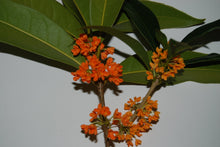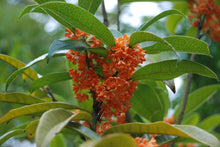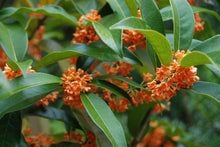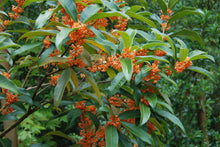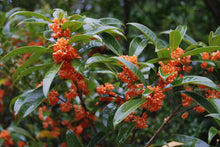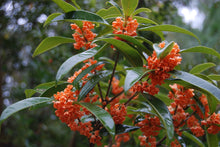Osmanthus fragrans aurantiacus 'Beni Kin Mokusei'
Regular price
$28.00
Sale
"Red" Flowering Osmanthus. Actually it is a deeper orange than the typical form "aurantiacus". One of my most cherished objects for my plant searches through the years has been to find the much heralded "Red Flowering Fragrant Tea Olive." The late Dr. J. C. Raulston of NCSU put me on this quest when he told the story of seeing one in an urn in full flower in a temple garden in Korea. He said that he would have almost risked jail for getting a cutting from this plant. Then some years ago a gentleman contacted me by e-mail and informed me that we had the largest selection of the genus Osmanthus on the internet. I don't know how true that is, but he wanted to find the Red Flowering Osmanthus fragrans. His wife, who is native Chinese, was from a city in China whose city flower was the aforementioned plant. When he visited her home town, he asked to see the Red Flowering Osmanthus growing there. He informed me that he was escorted to the outskirts of town and shown plants, which in his words, "...were not bushes, but trees." I have seen pictures of mature Osmanthus fragrans in China and they literally resemble an Asian evergreen Oak, such as Quercus acuta or Quercus myrsinifolia. On my visit to Japan in December, 2007, I saw two different nurseries that were offering this particular selection. The difference was that they had color tags with a picture of the whole plant in flower as well as a close up of individual flowers. The picture showed a brilliant orange-red flower. But now that it has flowered for us, we know that it is just a deeper orange than the our typical orange flowering "aurantiacus." This is definitely a different clone than the orange-flowering clone that we have grown for years, and it is just as fragrant, but it is more showy with its larger flowers. Now six years later, my first plants have flowered, and yes, they are a deeper orange than the clone of "aurantiacus" that we have offered for years, and the individual flowers are also larger as well, and the leaves are also larger than the species. The first photo shows our old clone on the right, and the deeper orange stem on the left with this new form. The cultivar name, 'Beni Kin Mokusei,' when translated from Japanese actually simply means "Red Flowering Osmanthus." After traveling to Japan many times, I have come to realize that when one sees 'Beni' in a cultivar name, the plant in question can be red, orange or pink. After observing this plant in our landscapes now for several years, we have noticed that this cultivar comes into flower 4-6 weeks earlier than Osmanthus fragrans aurantiacus.
Zones 7-9
Check out our Osmanthus Care Guide.







